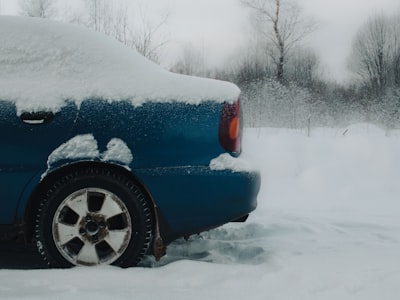If you have little or no experience driving in the snow, don't wait until it's too late to prepare for the worst. Winter driving techniques differ from those used in clear or even rainy conditions. If possible, practice with someone with experience. Experiment a little to get an idea of how the car responds in the snow by practicing in open areas where there is no traffic. 
Winterize Your Vehicle
Keep your car in good working condition. A typical trip will usually take longer in winter weather, so make sure you have more than enough gas in the tank. Have an ice scraper and brush ready to clear the car before driving. You may get stuck miles from home, so have warm clothing or a blanket with you. Keep distractions to a minimum. Don't drive during a storm unless it's necessary. If you have to go out while it's snowing, then use these tips to help you get home safely.
Use Brakes Sparingly
Drivers familiar with snowy roads know that, as a rule, the chances of making it to their destination without incident increase with sparse use of the brakes. At first it may seem contrary to intuition but braking, especially when the pedal is held firmly down without release, is one of the main reasons cars slide in the snow. Pumping the brakes reduces the likelihood that a car will slide out of control because this action intermittently releases the pressure. Releasing the pressure on the brakes either makes the wheels turn which increases traction and prevents sliding, or if the car is already sliding will change the car's direction. By forcing them to release at intervals, anti-lock brakes stop or decrease sliding.
Drive at Safe Speeds for the Conditions
Simply driving slower, at a reasonable speed for the conditions, is good advice. You won't need to change speeds or stop completely as often. Time your arrival as you approach a red light, pumping the brakes enough to slow the car so that a full stop becomes unnecessary. Even if the car is traveling at a negligible speed, while it is moving there's much less chance the car will become stuck from lack of traction, or that it will go out of control when you reapply the gas after stopping.
Changing gears in a car with an automatic transmission can also make the car spin out of control. Take care how often, where and the speed with which you do it.
Keep a Safe Distance
Stopping takes longer and making quick stops in the snow always increases the risk that the car will go out of control.
Ensure Your Car Will Perform in the Snow
Some types of vehicles are better than others in the snow, but there are ways to maximize your car’s performance. Good windshield wipers, plenty of non-freezing wiper fluid and working window defrosters make a big difference for obvious reasons. If you find yourself speeding up at most turns because that is the only way your car will push through the snowy muck, then the time to check the tire treads is long overdue. The benefits of good tires with adequate air pressure and tread cannot be overstated. You will appreciate the investment.
Remain Calm
Some accidents are unavoidable, but if you stay calm you will be better able to make intelligent decisions that may save your life.
Get the coverage you need. Call Stewart Kriese Ins Agency, Inc. at 559-846-7389 for more information on Kerman, CA auto insurance.